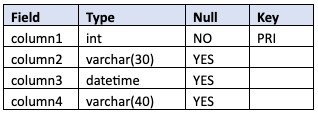Правило автоматизации Jira при слиянии запроса pull
Last modified: October 22, 2019
In some cases, you may have a table with many fields and desire to write a query that selects nearly all of them. In a situation like this, it would be nice to be able to write a query that combines a SELECT all with a shorter list of exclusions.
Unfortunately, since SQL is a declarative language, this cannot be done. When we use SQL, we must specify what we want, not what we do not want. The 2 best viable ways to approach this problem are as follows:
За рамками Agile
List out all columns in your query, omit the undesired fields by:
- Not including
- Deleting
Commenting out
Not including columns or deleting columns you don’t want in your SELECT statement is straightforward. However if you would want to show that you are leaving out certain columns intentionally you can comment them out by using two dashes –
SELECT
column1,
--column2,
column4
FROM
table_name;Here we deleted column3 and commented out column 2.
The SQL DESCRIBE statement is useful here to obtain the full list of the fields in a table, especially if there are a great number.
DESCRIBE table_name;
It will produce a table with all column names from the table being described and some other meta information.

За рамками Agile
If you will often be querying a table and retrieving most of its columns, then it may make sense to create a view. The view would persist as a “virtual table,” against which SELECT * queries could be run.
Here is how it would look if we wanted to end up with all of the columns except column2:
CREATE VIEW view_name AS
SELECT
column1,
column3,
column4
FROM table_name;This view could then be queried using SELECT *
SELECT *
FROM view_name;In theory this is a very good idea, however as the view definition becomes more extensive and/or complex, there could be a negative performance impact. Since the view is a “virtual table” the data does not reside within the view. Each time a query is made against the view, the view’s definition query against the original database tables must also run. The convenience gained by being able to SELECT * should be weighed against the time and resources needed to support the view.
Written by: Josiah Faas
Reviewed by: Matt David